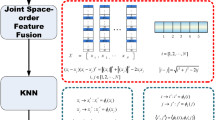Abstract
With the widespread use of smart phones and tablet computers, it is necessary to develop algorithms to assist high throughout analysis of mobile videos. A novel method for automated segmentation on the mobile video scenery is proposed in this paper. It uses the kernelized random walks on the globe KNN graph and the Smooth Representation Clustering to improve the segmentation effectiveness. The high order transition probability matrix of the kernelized random walks is utilized for erasing the unreliable edge of the graph. Simultaneously kernel approach is used to assign different weights for neighbors to evaluate their contribution to the clustering. The method is evaluated on two public datasets and a real-world mobile video taken by a smart phone. The experimental results show that the proposed algorithm achieves better performance compared with the other representative algorithms.
Access this chapter
Tax calculation will be finalised at checkout
Purchases are for personal use only
Similar content being viewed by others
References
Wang, J., Xu, M., Lu, H.: ActiveAd: a novel framework of linking ad videos to online products. Neurocomputing 185, 82–92 (2016)
Vidal, R.: A tutorial on subspace clustering. IEEE Signal. Proc. Mag. 28(2), 52–68 (2011)
Elhamifar, E., Vidal, R.: Sparse subspace clustering: algorithm, theory, and applications. IEEE Trans. Pattern Anal. Mach. Intell. 35(11), 2765–2781 (2013)
Elhamifar, E., Vidal, R.: Sparse subspace clustering. In: IEEE Conference of Computer Vision and Pattern Recognition (CVPR 2009), Florida, pp. 2790–2797 (2009)
Elhamifar, E., Sapiro, G., Sastry, S.: Dissimilarity-based sparse subset selection. IEEE Trans. Pattern Anal. Mach. Intell. PP(99), 1 (2015). doi:10.1109/tpami.2015.2511748(2015)
Jun, X., Kui, X.: Reweighted sparse subspace clustering. Comput. Vis. Image Underst. 138, 25–37 (2015)
Liu, G., Lin, Z., Yan, S., Sun, J., Yu, Y., Ma, Y.: Robust recovery of subspace structures by low-rank representation. IEEE Trans. Pattern Anal. Mach. Intell. 35(1), 171–184 (2012). doi:10.1109/tpami.2012.88
Lu, C.-Y., Min, H., Zhao, Z.-Q., Zhu, L., Huang, D.-S., Yan, S.: Robust and efficient subspace segmentation via least squares regression. In: Fitzgibbon, A., Lazebnik, S., Perona, P., Sato, Y., Schmid, C. (eds.) ECCV 2012. LNCS, vol. 7578, pp. 347–360. Springer, Heidelberg (2012). doi:10.1007/978-3-642-33786-4_26
Chen, L.F., Guo, G.D., Jiang, Q.S.: Adaptive algorithm for soft subspace clustering. J. Softw. 21(10), 2513–2523 (2010)
Lu, C.Y., Lin., Z., Yan, S.: Correlation adaptive subspace segmentation by trace lasso. In: IEEE International Conference on Computer Vision (ICCV), Sydney, VIC, pp. 1345–1352 (2013)
Hu, H., Lin, Z.C., Feng, J.J., Zhou, J.: Smooth representation clustering. In: 2014 IEEE Conference on Computer Vision and Pattern Recognition (CVPR), Columbus, OH, pp. 23–28 (2014)
Cao, J.Z., Chen, P., Dai, Q.Y., Ling, W.K.: Similarity graph construction method based on Markov random walker for spectral clustering. J. Nanjing Univ. (Nat. Sci. Chin. Version) 51(4), 772–779 (2015)
Kakutani, S.: Markov processes and the Dirichlet problem. Proc. Jpn. Acad. 21, 227–233 (1945)
İnkaya, T.: A parameter-free similarity graph for spectral clustering. Expert Syst. Appl. 42(24), 9489–9498 (2015)
Grady, L.: Random walks for image segmentation. IEEE Trans. Pattern Anal. Mach. Intell. 28(11), 1768–1783 (2006)
Grady, L.: Multilabel random walker image segmentation using prior models. In: IEEE Conference of Computer Vision and Pattern Recognition (CVPR 2005), San Diego, vol. 1, pp. 763–770 (2005)
Grady, L., Sinop, A.K.: Fast approximate random walker segmentation using eigenvector precomputation. In: IEEE Conference of Computer Vision and Pattern Recognition (CVPR 2008), Anchorage, Alaska, pp. 24–26 (2008)
Sonu, K.J., Purnendu, B., Subhadeep, B.: Random walks based image segmentation using color space graphs. Proc. Technol. 10(2013), 271–278 (2013)
Yang, X.L., Su, Y., Duan, R.B., Fan, H.J., Yeo, S.Y., Lim, C., Zhang, L., Tan, R.S.: Cardiac image segmentation by random walks with dynamic shape constraint. IET Comput. Vis. 10(1), 79–86 (2016)
Mitr, S.K., Sicuranza, G.L.: Nonlinear image processing, pp. 274–278. Academic Press, Cambridge (2001)
Schölkopf, B., Smola, A., Müller, K.R.: Nonlinear component analysis as a kernel eigenvalue problem. Neural Comput. 10(5), 1299–1319 (1998)
Ramponi, G., Strobel, N.K., Mitra, S.K., Yu, T.H.: Nonlinear unsharp masking methods for image contrast enhancement. J. Electron. Imaging 5(3), 353–366 (1996)
Li, H., Adali, T.: Complex-valued adaptive signal processing using nonlinear functions. EURASIP J. Adv. Sign. Process. 2008, 122 (2008)
Tron., R., Vidal, R.: A benchmark for the comparison of 3-d motion segmentation algorithm. In: IEEE Conference of Computer Vision and Pattern Recognition (CVPR 2007), Minneapolis, Minnesota, pp. 1–8 (2007)
Kanatani, K., Sugaya., Y.: Multi-state optimization for multi-body motion segmentation. In: Proceedings of Australia-Japan Advanced Workshop on Computer Vision, Adelaide Australia, pp. 25–31 (2003)
Hull, J.J.: A database for handwritten text recognition research. IEEE Trans. Pattern Anal. Mach. Intell. 16(5), 550–554 (1994)
Acknowledgments
This work was supported by Chinese National Natural Science Foundation under Grant Nos. 61672157, 41601477, it is also supported by the Leading project in Science and Technology Department of Fujian Province under Grant No. 2015Y0054.
Author information
Authors and Affiliations
Corresponding author
Editor information
Editors and Affiliations
Rights and permissions
Copyright information
© 2017 Springer International Publishing AG
About this paper
Cite this paper
Chen, L., Guo, G., Chen, L. (2017). Smooth Representation Clustering Based on Kernelized Random Walks. In: Song, S., Renz, M., Moon, YS. (eds) Web and Big Data. APWeb-WAIM 2017. Lecture Notes in Computer Science(), vol 10612. Springer, Cham. https://doi.org/10.1007/978-3-319-69781-9_1
Download citation
DOI: https://doi.org/10.1007/978-3-319-69781-9_1
Published:
Publisher Name: Springer, Cham
Print ISBN: 978-3-319-69780-2
Online ISBN: 978-3-319-69781-9
eBook Packages: Computer ScienceComputer Science (R0)




